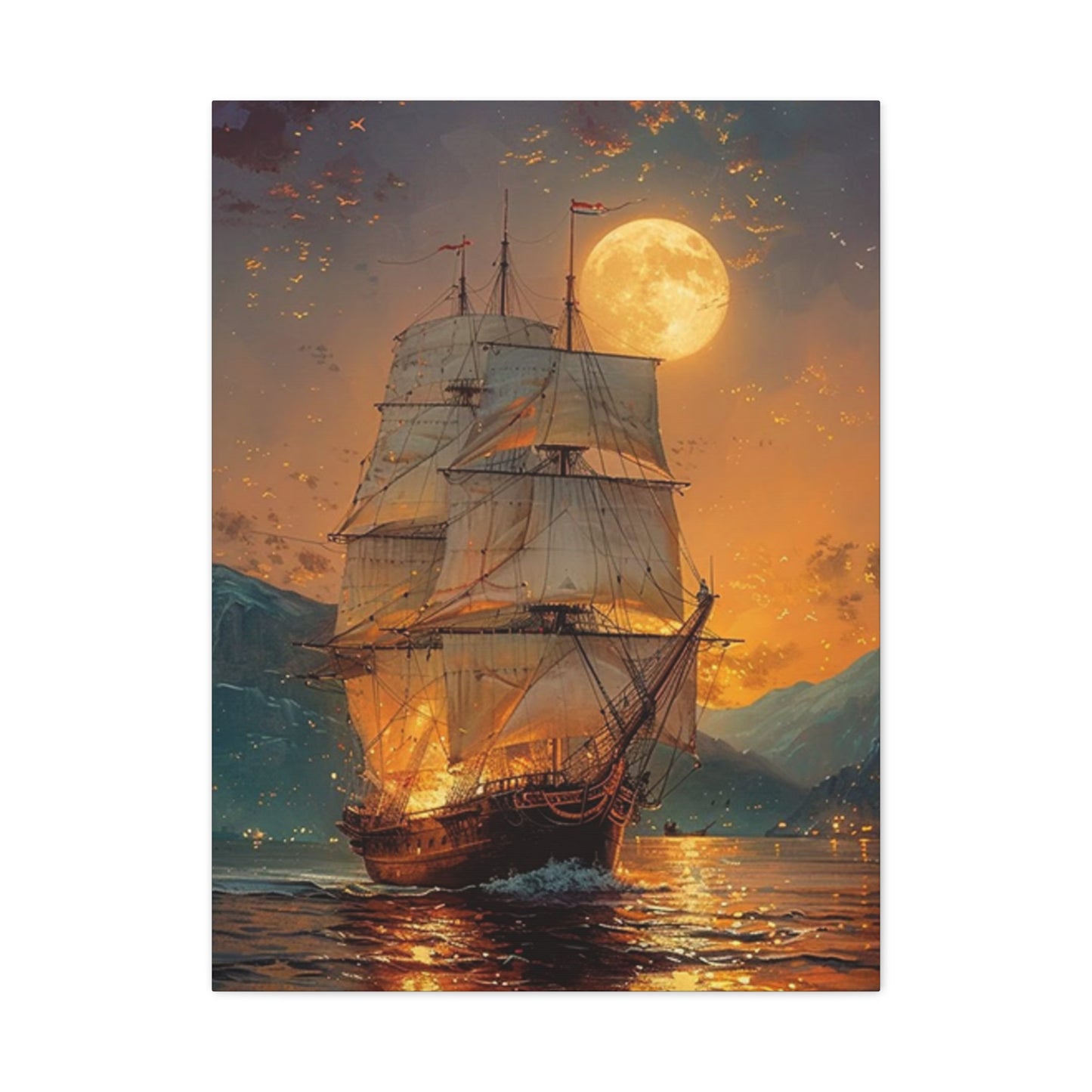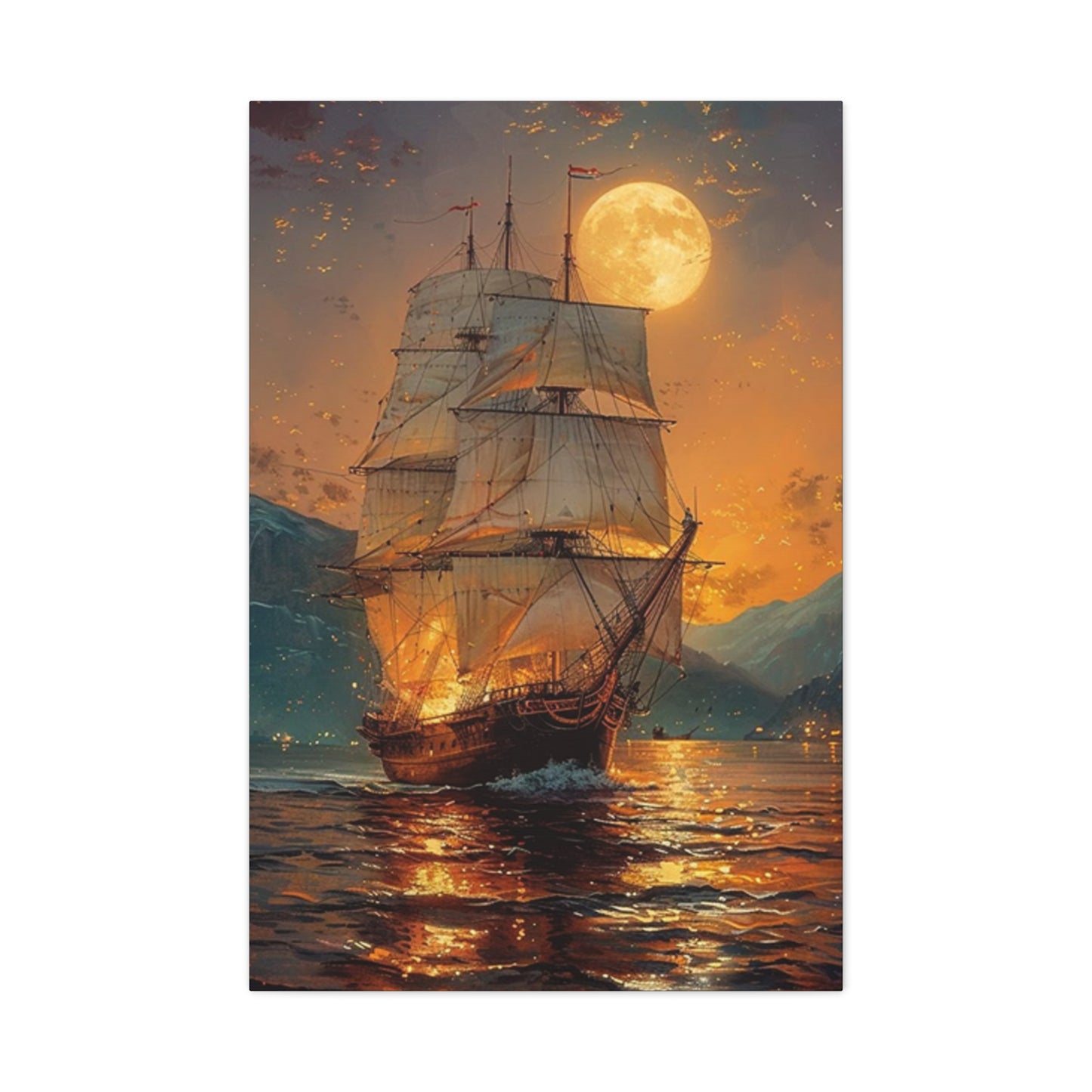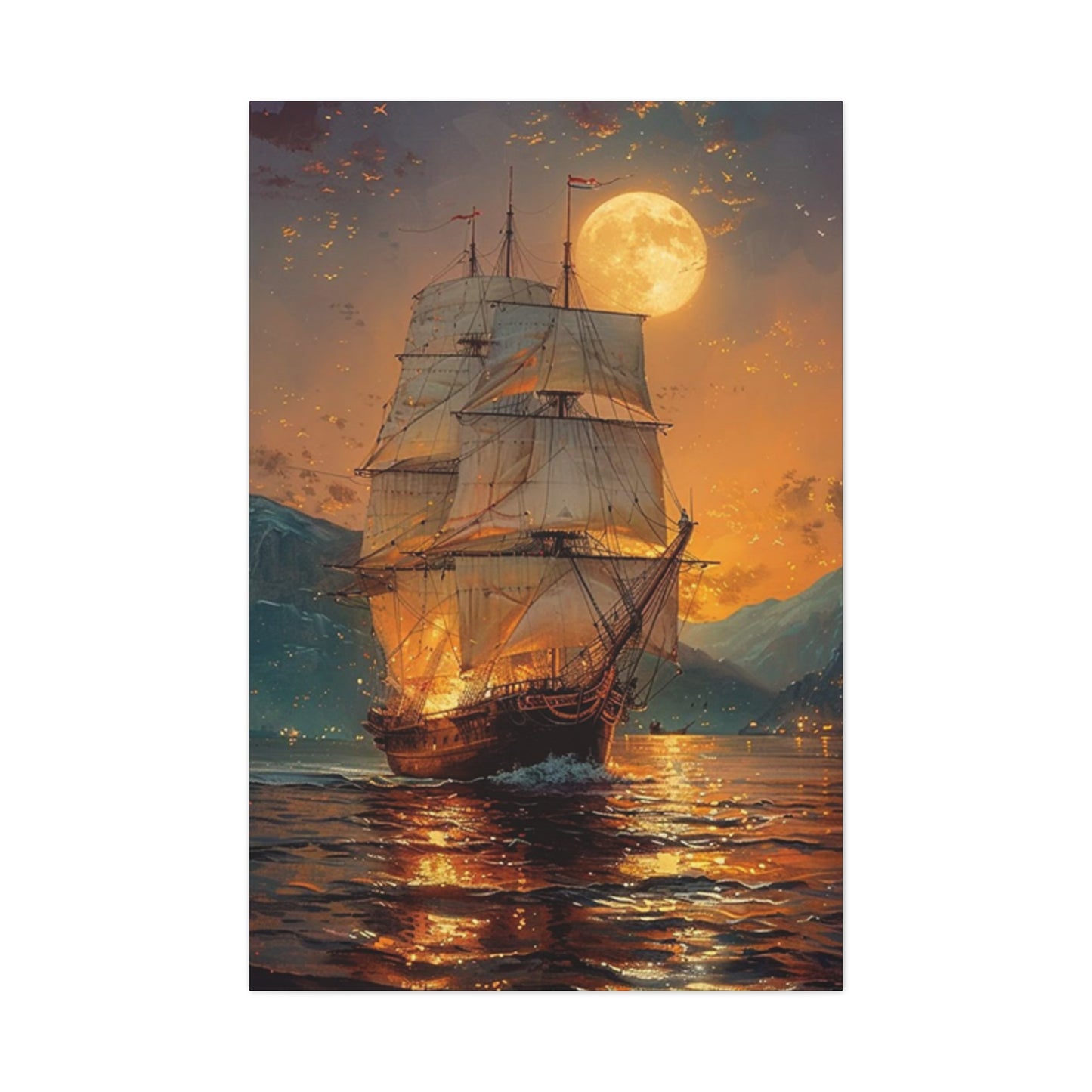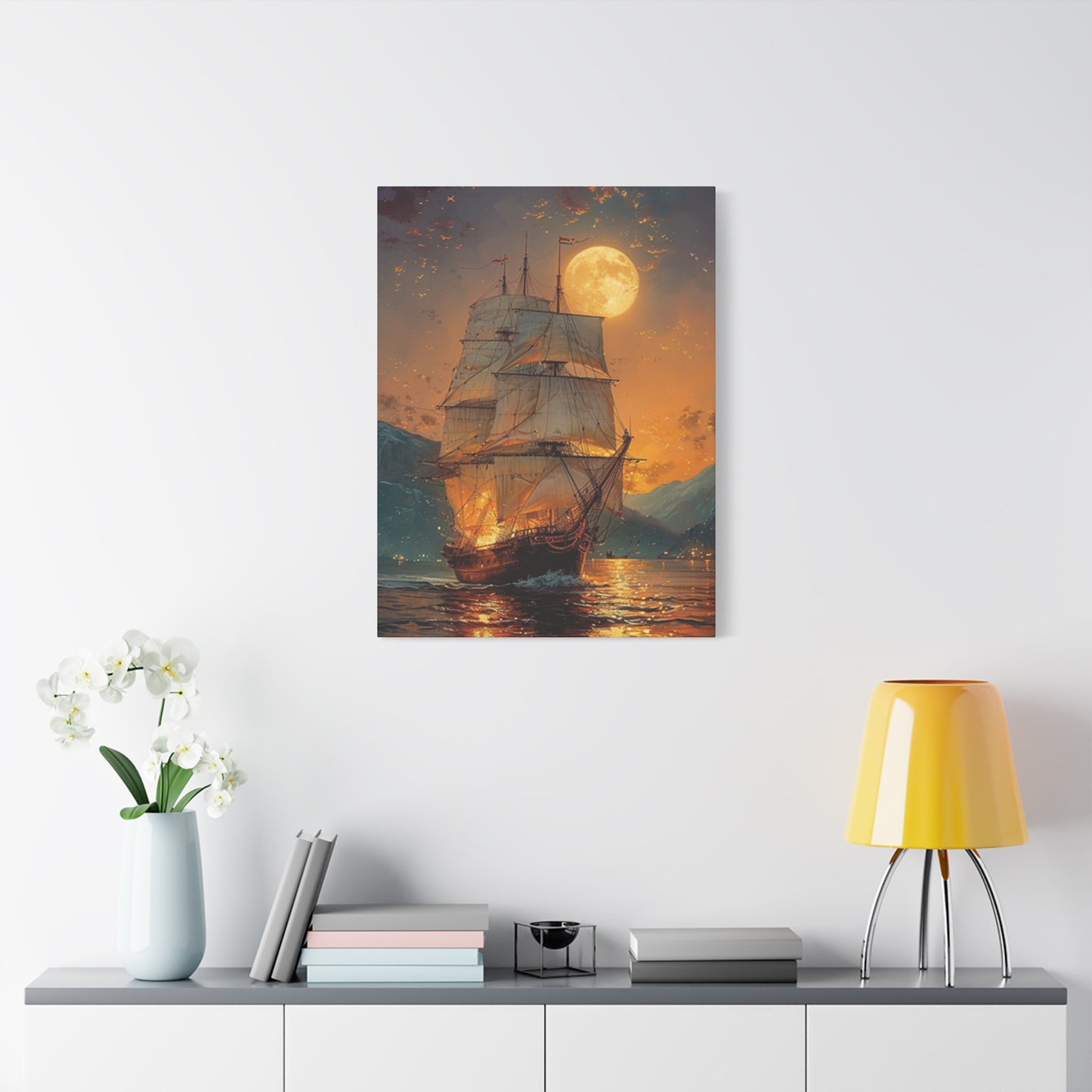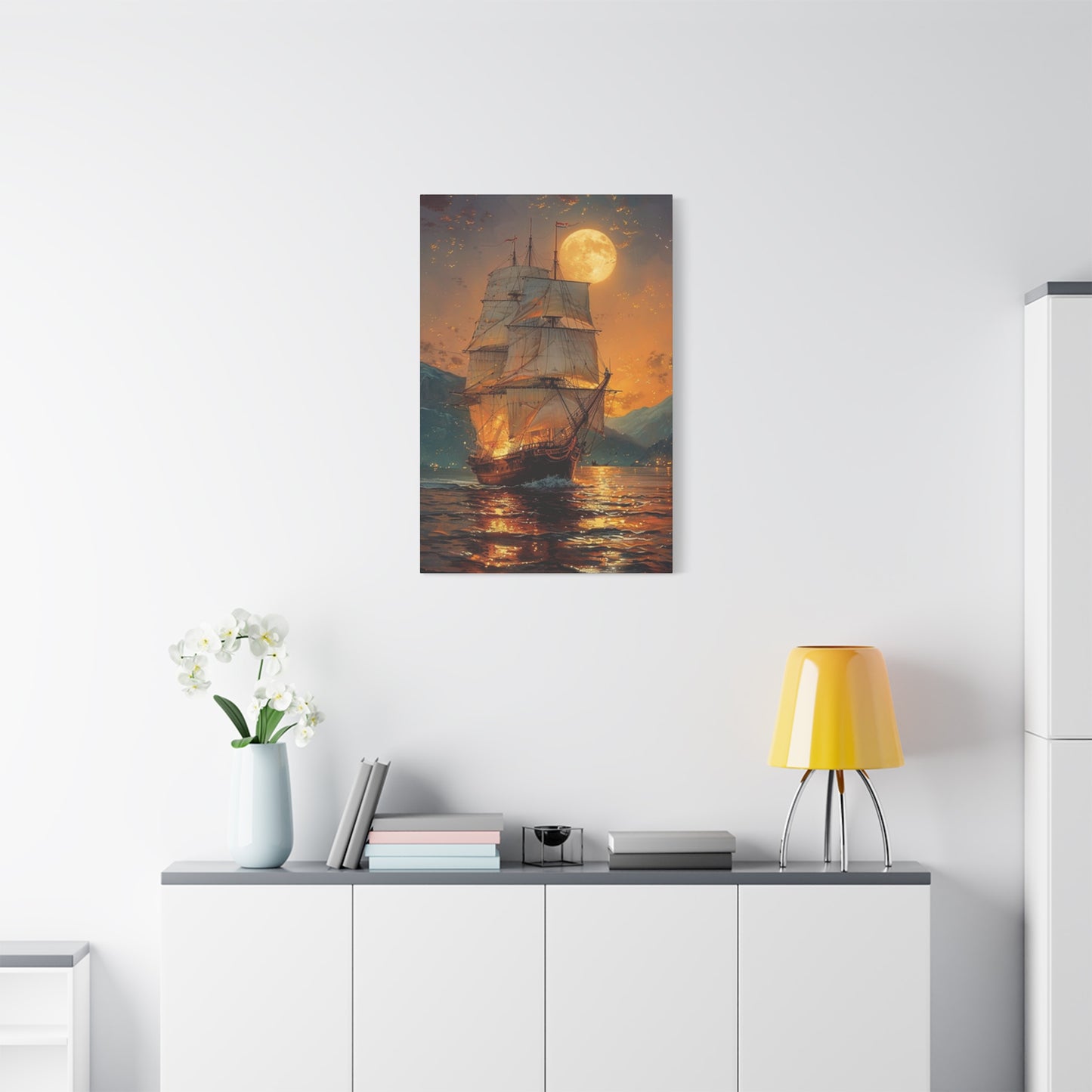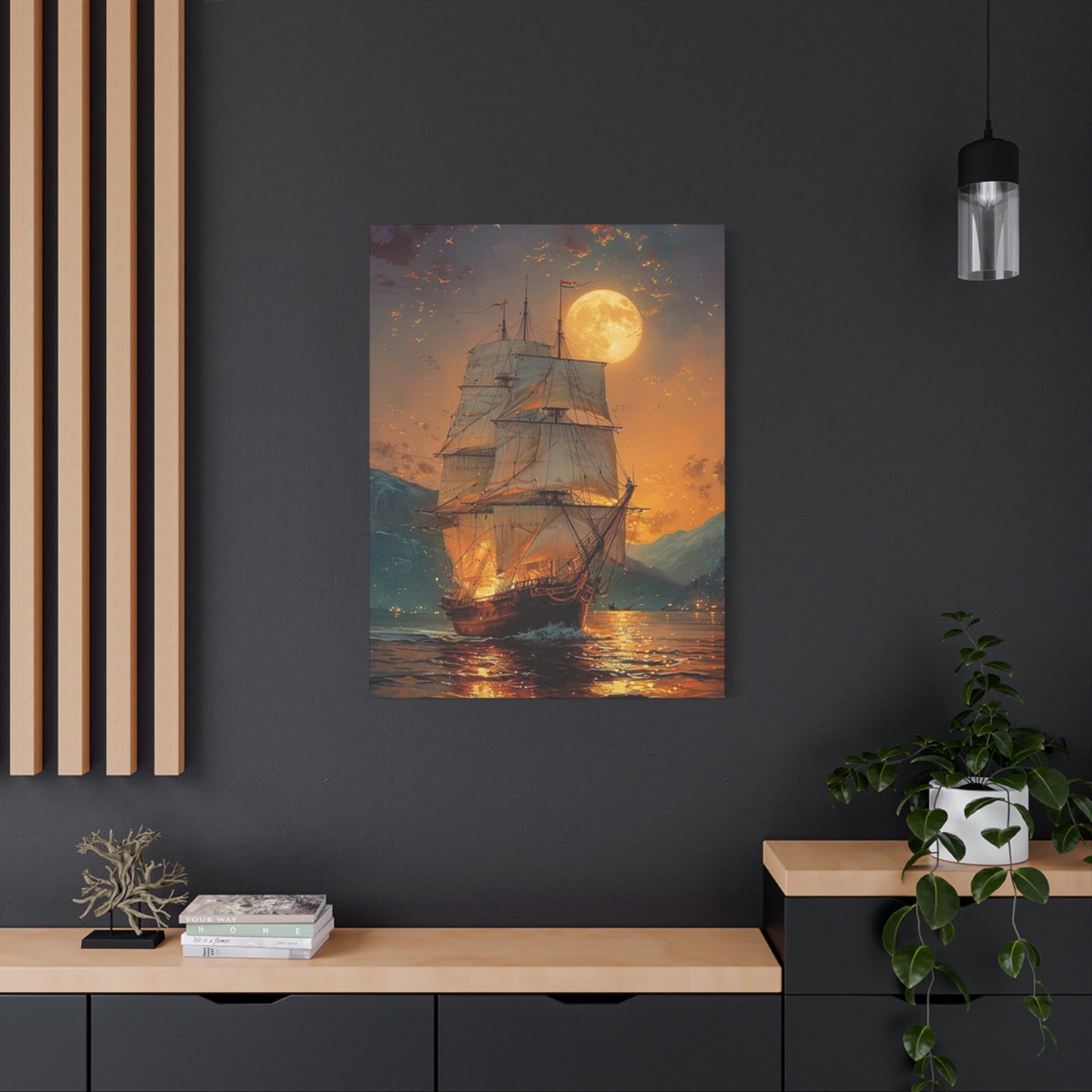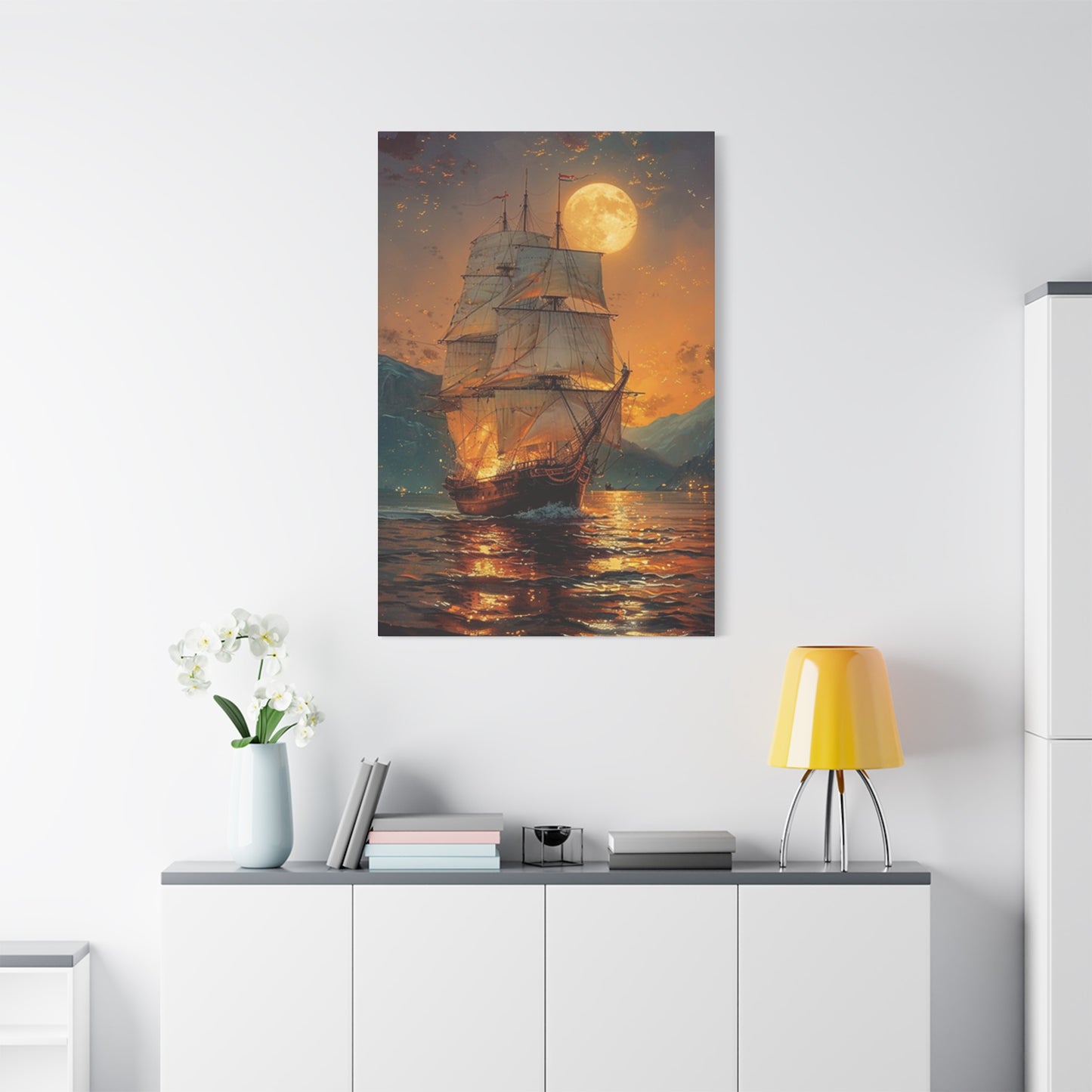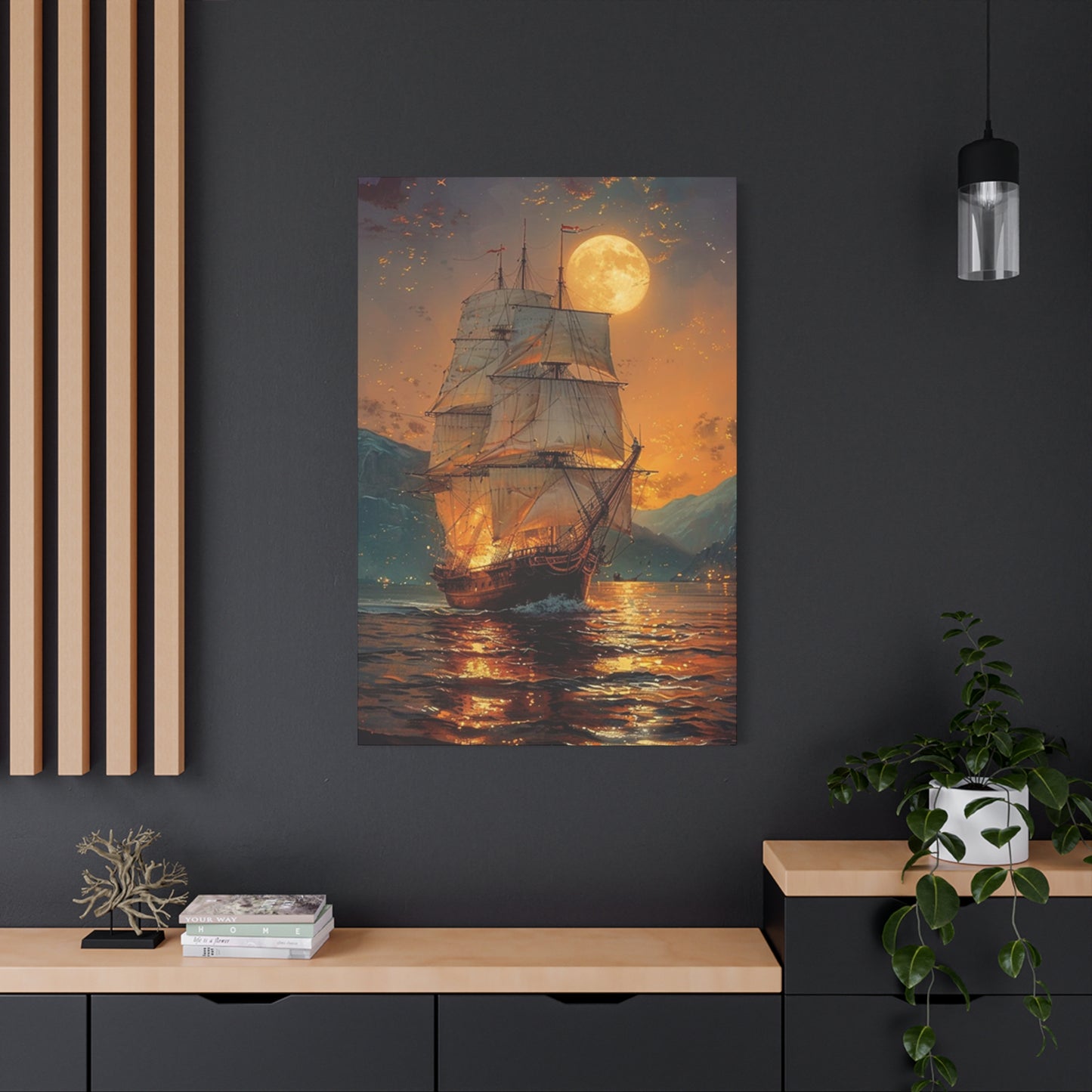An Ocean of Twilight: The Enduring Charm of Ship Sailing in Evening Wall Art
The image of a ship sailing into the embrace of the evening sky is one of the most powerful and enduring motifs in the world of art and decor. It is a scene that speaks to something primal within the human spirit: a yearning for adventure, a contemplation of journeys ending and beginning, and a deep appreciation for the profound beauty of the natural world. This specific genre of artwork, the ship-sailing-in-evening-wall-art, is more than just a decorative element; it is a portal to a world of tranquility, nostalgia, and boundless possibility. It captures a fleeting moment of perfect balance—between the fading light of day and the encroaching mystery of night, between the steadfastness of the vessel and the infinite expanse of the sea.
In homes and offices around the globe, these pieces serve as silent storytellers, whispering tales of maritime history, personal reflection, and the serene majesty of the ocean at dusk. This comprehensive exploration delves into every facet of this captivating art form, from its deep symbolic roots and diverse artistic interpretations to its practical application in interior design and its profound psychological impact on the observer. We will navigate the rich history, analyze the technical elements that bring these scenes to life, and provide guidance on how to choose, style, and preserve these timeless treasures, allowing you to fully appreciate and integrate the serene power of a ship sailing at twilight into your own personal space.
The Timeless Pull of the Nautical Horizon
The allure of the nautical horizon has captivated humanity for millennia. It represents the ultimate boundary between the known and the unknown, a line that promises both immense opportunity and formidable challenges. When this horizon is the backdrop for a ship sailing in the evening, its magnetic pull intensifies. This imagery taps into a collective consciousness filled with stories of exploration, trade, and migration across vast, untamed waters. A piece of ship-sailing-in-evening-wall-art is not merely a picture of a boat on the water; it is a profound statement about human ambition, resilience, and our intrinsic connection to the vastness of the world. The horizon at dusk, painted in the soft, warm hues of the setting sun, adds a layer of peace and finality to the scene. It suggests a journey’s satisfactory conclusion or a peaceful transition into a state of rest. This visual metaphor for passage and change resonates deeply, offering a sense of perspective in our often chaotic lives. The gentle gradient of colors, from fiery orange and deep crimson to soft lavender and indigo, creates a visual symphony that is inherently calming. This powerful combination of a man-made vessel, a symbol of our ingenuity and determination, against the infinite and ever-changing canvas of the sea and sky, creates a dynamic tension and a beautiful harmony that ensures its appeal is truly timeless and universal.
Symbolism of a Ship Sailing into the Sunset
A ship sailing into the sunset is an image laden with rich and multifaceted symbolism, which is a primary reason for its popularity as a theme for wall art. On one level, it is the quintessential symbol of a journey's end, a return home after a long and arduous voyage. This interpretation brings feelings of comfort, accomplishment, and peace, making ship-sailing-in-evening-wall-art an ideal addition to spaces meant for relaxation and unwinding, such as a bedroom or a living room. Conversely, the very same image can symbolize a departure, a venturing forth into the unknown mysteries that the night and the sea hold. In this light, the artwork becomes a beacon of adventure, courage, and the pursuit of new horizons. It speaks to the explorer within us all, encouraging us to embrace change and face the future with confidence. Furthermore, the setting sun itself is a powerful metaphor for the cycles of life, representing endings, transitions, and the promise of a new dawn. When combined with the vessel, the art piece becomes a poignant reflection on life's passages, the passage of time, and the serene acceptance of life's natural rhythms. This depth of meaning allows the artwork to connect with individuals on a deeply personal level, with each viewer drawing their own unique interpretation and solace from the scene. It’s this ability to be both a comforting anchor and an inspiring call to adventure that gives this particular art theme its profound emotional weight and lasting appeal.
Capturing the Golden Hour: The Magic of Evening Light
The period just before sunset and shortly after, known as the "golden hour," is a time when the world is bathed in a warm, diffused, and magical light. This is the light that artists and photographers cherish above all others, and it is the defining characteristic of ship-sailing-in-evening-wall-art. The low angle of the sun creates long, soft shadows and illuminates subjects with a rich, golden hue that is impossible to replicate at any other time of day. In a maritime scene, this light works wonders. It makes the surface of the water shimmer and dance, reflecting the fiery colors of the sky in a dazzling display. The sails of the ship catch this golden light, appearing to glow from within, transforming them from simple pieces of canvas into radiant banners of light. The very air seems thick with color and warmth, creating an atmosphere of profound peace and beauty. Artwork that successfully captures this fleeting moment allows the viewer to experience this magic indefinitely. The artist's challenge and triumph lie in translating the unique quality of this light onto canvas or paper. Through skillful use of color, blending, and contrast, they can convey the soft warmth that envelops the entire scene, from the intricate rigging of the ship to the gentle roll of the waves. It is this masterful depiction of the golden hour that elevates a simple seascape into a truly breathtaking piece of art, one that can transform a room by infusing it with the serene and ethereal glow of a perfect sunset.
The Realism Approach: A Window to the Ocean
Realism in art seeks to represent subjects truthfully, without artificiality and avoiding artistic conventions, as well as exotic and supernatural elements. When applied to ship-sailing-in-evening-wall-art, the realism approach aims to create a window onto a genuine maritime moment, so convincing that one can almost smell the salt in the air and hear the gentle lapping of waves against the hull. Artists who work in this style are masters of detail and observation. They pay meticulous attention to the anatomy of the ship, ensuring every mast, sail, and rope is rendered with nautical accuracy. The play of the low evening light is studied with scientific precision—how it reflects off the wet deck, illuminates the texture of the canvas sails, and glints off the brass fittings. The water itself is a complex subject, with the artist capturing the translucency of the waves, the subtle shifts in color from deep blue to sun-kissed gold, and the intricate patterns of foam and ripples. The sky is another canvas for this detailed approach, with clouds rendered in soft, believable forms and the color gradient of the sunset depicted with photorealistic smoothness. This style of artwork appeals to viewers who appreciate craftsmanship and a deep connection to the real world. It offers not an interpretation, but a faithful representation, inviting the viewer to step into a scene that feels tangible and immediate. It is a testament to the artist's skill and a celebration of the profound, unembellished beauty of the natural world.
The Romanticism of Tall Ships in Evening Wall Art
The era of Romanticism in art, peaking in the early 19th century, emphasized emotion, individualism, and the glorification of nature's awe-inspiring power. Tall ships, with their towering masts and billowing sails, were a favorite subject of Romantic painters, and this legacy continues in contemporary ship-sailing-in-evening-wall-art. A piece created in a Romantic style will often feature a majestic galleon, clipper, or schooner, depicted with a sense of drama and grandeur. The evening setting is not just beautiful but sublime—a term Romantics used to describe experiences of nature that were so vast and powerful as to be overwhelming and emotionally stirring. The sky might be filled with dramatic, roiling clouds, lit from beneath by a fiery, almost supernatural sunset. The sea could be shown as a powerful, untamed force, with the ship bravely navigating its swells. The artwork aims to evoke powerful emotions: awe at the beauty of nature, nostalgia for a bygone era of adventure, and a sense of the heroic struggle of humanity against the elements. The focus is on creating an atmosphere of heightened reality, where every color is more intense, every shadow deeper, and every line more expressive. This style of art appeals to those who are drawn to history, drama, and epic storytelling. It transforms a simple decorative piece into a narrative tableau, a grand vision of the sea that speaks to the heart's desire for passion, adventure, and connection to something larger than oneself.
Watercolor Seascapes: A Fluid and Ethereal Medium
Watercolor is a painting method in which the paints are made of pigments suspended in a water-based solution. Its inherent transparency and fluidity make it an exceptionally well-suited medium for depicting the delicate and transient beauty of a ship sailing at evening. The way watercolor pigments bleed and blend on the paper mimics the natural diffusion of light in the sky and the soft reflections on the water's surface. A watercolor artist can create a sunset sky that is luminous and airy, with soft-edged clouds and a seamless gradient of warm colors. The water can be rendered with a sense of translucency and movement, using washes of blue, green, and purple to suggest depth and ripples. The ship itself might be painted with more defined lines, yet it will still possess a certain softness, integrating it harmoniously into the fluid environment. The white of the paper is often used strategically to represent the brightest highlights—the glint of the setting sun on the water or the whitest part of a sail. This technique gives watercolor seascapes a unique, light-filled quality. A piece of watercolor ship-sailing-in-evening-wall-art often has a gentle, dreamlike, and slightly melancholic feel. It is perfect for creating a soft, serene atmosphere in a room, making it an excellent choice for bedrooms, reading nooks, or any space dedicated to quiet contemplation.
Oil Paintings: Rich Textures and Deep Colors
Oil paint is a traditional medium known for its richness, depth of color, and versatility. When used to create ship-sailing-in-evening-wall-art, oil paints allow for a level of vibrancy and texture that is difficult to achieve with other media. The slow-drying nature of oils enables artists to blend colors seamlessly, creating the smooth, subtle transitions of a twilight sky with unparalleled realism. They can also be applied thickly, a technique called impasto, to build up physical texture on the canvas. This can be used to represent the rough texture of the ship's hull, the thick canvas of the sails, or the crests of waves, adding a tactile, three-dimensional quality to the artwork. The pigments in oil paints are exceptionally rich, allowing for deep, resonant blues and blacks for the sea and night sky, contrasted with brilliant, luminous oranges, reds, and yellows for the sunset. This high contrast creates a dramatic and impactful image. An oil painting of a sailing ship at dusk can feel substantial and timeless, a nod to the great maritime painters of history. The layers of glaze and varnish that can be applied to a finished oil painting further enhance the depth and luminosity of the colors, making the light of the sunset seem to glow from within the canvas. For those seeking a classic, impactful, and richly detailed piece of art, an oil painting is an exemplary choice.
The Modern Digital Art Take on Classic Maritime Themes
In the digital age, artists have a new and powerful set of tools to reimagine classic themes. Digital art encompasses a wide range of techniques, from creating images from scratch using software like Adobe Photoshop or Procreate to manipulating and compositing photographs into fantastical scenes. A digital artist creating ship-sailing-in-evening-wall-art has limitless freedom. They can create sunsets with hyper-vibrant, impossible colors, or design fantastical ships that blend historical and futuristic elements. They can combine the sharp detail of photography with the expressive brushwork of painting, creating a unique hybrid style. Vector art, another form of digital creation, uses lines and geometric shapes to produce clean, scalable images, perfect for a modern or minimalist take on the nautical theme. Digital art can also incorporate elements of fantasy, perhaps showing a tall ship sailing through a sea of stars or towards a glowing, magical moon. The final artwork is typically produced as a high-quality print on canvas, metal, or archival paper, making it indistinguishable from traditional art in its physical form. This modern approach opens up the classic maritime theme to a new generation of art lovers, offering fresh, imaginative, and often breathtakingly beautiful interpretations that push the boundaries of what a seascape can be. It is an exciting frontier for an age-old subject, proving the enduring power of the sailing ship as a source of artistic inspiration.
A Deep Dive into Materials for Your Artwork
The material on which a piece of ship-sailing-in-evening-wall-art is printed or painted has a profound effect on its final appearance, durability, and the overall mood it creates in a room. The choice of material is as significant as the choice of the image itself. From the traditional warmth of canvas to the sleek, contemporary feel of metal, each substrate offers unique characteristics. A canvas print provides a classic, painterly texture that adds depth and artistic flair. A framed paper print behind glass offers a timeless, gallery-like elegance. For a more modern and vibrant look, high-gloss acrylic or metal prints can make the colors of the sunset pop with incredible intensity. Rustic interiors might be enhanced by an image printed directly onto wood, allowing the natural grain to show through and add character. Understanding the properties of each material—its texture, reflectivity, color rendition, and longevity—is crucial for selecting an artwork that not only resonates with you aesthetically but also complements your interior design style and meets your practical needs for durability and maintenance. This knowledge empowers you to make an informed decision, ensuring that your chosen piece of maritime art will be a cherished feature in your home for years to come.
The Classic Appeal of Canvas Prints
Canvas is perhaps the most popular and recognized material for wall art, and for good reason. A canvas print of a ship sailing at evening instantly evokes the feeling of a traditional painting, lending the artwork a sense of timelessness and artistic authenticity. The woven texture of the canvas surface adds a subtle, tactile dimension to the image, catching the light in a way that a flat paper print cannot. This texture is particularly effective for seascapes, as it can enhance the depiction of the rough-hewn sails, the wooden hull of the ship, or the choppy surface of the water. Canvas prints are typically stretched over a wooden frame, a technique known as a gallery wrap, which allows the image to continue around the edges. This creates a clean, three-dimensional look that can be hung without an external frame, offering a modern and minimalist presentation. Alternatively, a canvas print can be placed in a floater frame, which leaves a small gap between the canvas and the frame, creating the illusion that the artwork is levitating. Canvas is also a durable and lightweight material, making it easy to hang and less prone to damage than glass-framed prints. Its matte finish reduces glare, ensuring the artwork can be viewed comfortably from any angle and in various lighting conditions. This combination of classic aesthetic, versatility, and practicality makes canvas an enduringly popular choice for displaying beautiful nautical scenes.
The Sleek Modernity of Metal Wall Art
For a truly contemporary and striking presentation, metal wall art is an exceptional choice. When an image of a ship sailing at dusk is printed on a sheet of aluminum, the result is a piece with stunning clarity, vibrancy, and a unique luminous quality. The printing process, often dye-sublimation, infuses the dyes directly into the metal's coating, creating an image that is not only incredibly detailed but also highly durable, waterproof, and scratch-resistant. Metal prints are known for their brilliant color reproduction, which makes the fiery oranges, deep reds, and rich purples of a sunset scene appear incredibly vivid and lifelike. The high-gloss finish often used for metal prints enhances this effect, making the light in the image seem to glow from within the piece itself, as if it were backlit. The sleek, frameless design, with the print appearing to float just off the wall, adds to the modern aesthetic. This material is perfect for contemporary, minimalist, or industrial-style interiors, where it can act as a bold and sophisticated focal point. Furthermore, metal prints are exceptionally easy to clean and are resistant to fading, making them a practical choice for any room, including kitchens or bathrooms where humidity might be a concern. A metal print transforms a beautiful nautical image into a sleek, durable, and breathtaking piece of modern art.
The Rustic Charm of Wood-Mounted Ship Art
Printing a ship-sailing-in-evening scene directly onto a panel of wood offers a unique and charmingly rustic aesthetic. This method allows the natural texture and grain of the wood to show through the image, becoming an integral part of the artwork itself. The wood grain can mimic the lines of waves on the water or the texture of clouds in the sky, adding a layer of organic beauty and unpredictability to the piece. The warmer tones of the wood also lend a soft, vintage, and earthy feel to the artwork, which can be particularly fitting for coastal, farmhouse, or cottage-style decor. The visible knots and imperfections in the wood ensure that each piece is entirely unique, a one-of-a-kind creation. The whites in the image are often not printed, allowing the natural color of the wood to stand in, which creates a muted, harmonious color palette. This type of art feels grounded and substantial, connecting the maritime theme to the natural world in a very direct and tactile way. It speaks of craftsmanship, of old wooden ships, and of a simpler time. For those looking to add warmth, character, and a touch of natural texture to their space, a wood-mounted print of a sailing ship at twilight is an excellent and distinctive choice, blending the beauty of the sea with the beauty of the forest.
High-Gloss Acrylic Prints for Vibrant Displays
Acrylic prints offer one of the most vibrant and visually stunning ways to display ship-sailing-in-evening-wall-art. In this process, the image is typically printed on high-quality photographic paper and then face-mounted to a sheet of polished acrylic. The light passes through the acrylic before reflecting off the print, and this refraction creates a remarkable sense of depth and luminosity. The colors of the sunset—the intense crimsons, glowing oranges, and deep indigos—appear incredibly saturated and rich, and the details of the ship and water are rendered with razor-sharp clarity. The high-gloss surface of the acrylic acts like a lens, enhancing the vibrancy and making the image appear almost three-dimensional, as if you are looking through a crystal-clear window out onto the ocean. This method gives the artwork a very modern, luxurious, and high-end feel. Like metal prints, acrylic prints are often mounted in a way that makes them appear to float off the wall, contributing to their clean and contemporary aesthetic. They are also highly durable, shatter-resistant, and offer natural protection against UV rays, which helps to prevent fading over time. For anyone wanting to make a bold statement and showcase the colors and details of their chosen seascape with the utmost impact, a high-gloss acrylic print is a superior and breathtaking option.
The Timeless Elegance of Framed Paper Prints
The traditional method of framing a high-quality paper print behind glass remains a timeless and elegant choice for displaying art. This classic presentation offers a level of customization and sophistication that is hard to match. The choice of paper is the first step; options range from matte archival paper, which has a smooth, non-reflective surface perfect for detailed images, to luster or semi-gloss papers that offer a slight sheen to enhance color vibrancy. The print is then often surrounded by a mat, a paper-based border that sits between the print and the frame. The mat serves two purposes: it prevents the print from touching the glass, which is important for preservation, and it creates a visual "breathing space" around the image, drawing the viewer's eye inward and enhancing its impact. The final element is the frame itself, which can be chosen to perfectly complement both the artwork and the room's decor. A rustic wooden frame might enhance a classic painting, while a sleek black or metallic frame could be ideal for a modern photograph. The glass or acrylic glazing protects the print from dust, moisture, and UV damage. This entire package—print, mat, frame, and glazing—creates a finished, gallery-worthy piece that feels intentional and refined. For a classic, customizable, and sophisticated display, the framed paper print is an eternally stylish option.
Integrating Ship Sailing Art into Your Home Decor
Successfully integrating a piece of ship-sailing-in-evening-wall-art into your home decor involves more than just hanging it on a nail. It requires thoughtful consideration of the room's style, color palette, scale, and lighting to ensure the artwork becomes a harmonious and impactful element of the overall design. The goal is to make the art feel like it truly belongs in the space, enhancing the existing decor while also standing out as a beautiful feature. A large, dramatic seascape can serve as the focal point of a living room, setting the tone for the entire space. In a bedroom, a more serene and smaller piece can contribute to a restful atmosphere. The style of the art should align with the style of the room—a minimalist print for a modern space, a classic oil painting for a traditional home. The colors within the artwork can be used as inspiration for the room's color scheme, picking out the deep blues of the sea or the warm oranges of the sunset for accent pillows, throws, or other decorative items. By strategically placing, lighting, and complementing your nautical artwork, you can elevate it from a simple picture on the wall to a key component that ties your entire interior design together, creating a cohesive, stylish, and personally resonant living space.
Creating a Focal Point in Your Living Room
The living room is often the heart of the home, and a compelling piece of ship-sailing-in-evening-wall-art can serve as a stunning focal point that anchors the entire space. To achieve this, scale is paramount. Choose a large, oversized piece to hang above the main sofa or fireplace. This commanding presence will immediately draw the eye and establish the room's primary visual theme. The artwork should be hung at eye level—typically with the center of the piece around 57-60 inches from the floor—to ensure it connects with the people in the room rather than floating too high. The colors of the artwork can then be used to inform the rest of the room's decor. Pull the deep navy from the sea for an accent wall or a plush rug. Use the warm, golden tones from the sunset for throw pillows, curtains, or decorative vases. This creates a cohesive and professionally designed look. The frame of the artwork, if it has one, should also complement the other finishes in the room, such as the wood of the coffee table or the metal of the light fixtures. By building the room's design around a magnificent seascape, you create more than just a decorated space; you create an environment with a distinct mood, a story, and a powerful, captivating centerpiece that sparks conversation and inspires tranquility.
Bringing Tranquility to the Bedroom with Seascape Art
The bedroom is a sanctuary, a place for rest, relaxation, and rejuvenation. The inherent calmness of a ship sailing at evening makes this theme an ideal choice for bedroom wall art. The goal here is to create a serene atmosphere that promotes peaceful sleep. A piece featuring soft, muted colors—gentle blues, lavenders, and pale pinks—is often more suitable than one with fiery, high-energy reds and oranges. The style could be impressionistic or watercolor, enhancing the soft, dreamlike quality of the scene. Consider placing the artwork on the wall you see first when you enter the room, or on the wall opposite the bed, so it is the last thing you see before you fall asleep and the first thing you see when you wake up. A horizontal, panoramic piece hung above the headboard can also be very effective, creating a sense of expanse and calm. The key is to choose an image that you personally find soothing and contemplative. It should be a window to a peaceful world, a visual cue to your mind and body to let go of the day's stresses and drift into a state of deep relaxation. Paired with soft lighting and comfortable textiles, a tranquil piece of ship-sailing-in-evening-wall-art can transform your bedroom into the ultimate restful retreat.
Nautical Nuances for a Sophisticated Home Office
A home office requires a balance of inspiration and focus, and the right artwork can play a crucial role in creating this productive environment. A piece of ship-sailing-in-evening-wall-art can be a perfect addition, offering both a calming visual break and a potent metaphor for journey, ambition, and navigating challenges. For a sophisticated office space, opt for a more refined and less literal interpretation of the theme. A minimalist line drawing, a dramatic black-and-white photograph, or a stately oil painting of a historic vessel can all add a touch of elegance without being distracting. The symbolism of the ship steadily moving forward can serve as a subtle motivator, a reminder of long-term goals and the persistence required to reach them. The calming colors of the sea and sky can help to reduce work-related stress and create a more focused atmosphere. Hang the artwork on a wall that you can see from your desk, perhaps behind your monitor, to allow for moments of brief visual meditation during the day. The theme of exploration and enterprise inherent in nautical art aligns perfectly with the professional world, making it a fitting and inspiring choice that adds personality and depth to a workspace, elevating it from a mere room with a desk to a true command center for your professional endeavors.
Welcoming Guests with Maritime Art in the Entryway
The entryway or foyer is the first impression your home makes on guests, and the artwork you choose for this space sets the tone for the rest of your home. A beautiful piece of ship-sailing-in-evening-wall-art can be an incredibly welcoming and intriguing choice. It immediately establishes a mood of peace and timeless elegance. The imagery of a ship can symbolize a safe harbor and a welcome return home, which is a wonderful sentiment to greet visitors with. It also serves as a great conversation starter, a piece that guests will naturally be drawn to and comment on. For a narrow entryway, a vertically oriented piece can help to draw the eye upward, creating a sense of height and space. In a larger foyer, a significant, horizontally oriented seascape can create a dramatic and inviting vista. The lighting in the entryway is crucial; ensure the artwork is well-lit with a dedicated picture light or well-placed ceiling lights to bring out its colors and details. By placing a carefully chosen piece of maritime art in your entryway, you create a thoughtful and memorable introduction to your home's personality, promising a space of comfort, beauty, and intriguing stories within.
Coastal Decor Themes: Beyond the Beach House
The coastal decor style is about capturing the light, airy, and relaxed feeling of being by the sea, and it is a style that can be beautifully adapted to any home, not just one with an ocean view. Ship-sailing-in-evening-wall-art is a natural and sophisticated element within this theme. To create a modern coastal look, move beyond the clichés of seashells and anchors and focus on a refined color palette and natural textures. Start with a base of whites, sandy beiges, and soft greys. Then, use your artwork as the primary source of color. Pull the deep blues, sea greens, and sunset corals from the painting and use them as accents throughout the room in pillows, throws, and decorative objects. Incorporate natural materials that evoke a coastal feel, such as light-colored wood furniture, jute or sisal rugs, and linen curtains that billow in the breeze. The artwork itself should feel elevated—a large-scale canvas or a high-quality framed print will feel more sophisticated than a collection of small, themed pictures. The goal is to evoke the essence of the coast—the light, the space, the tranquility—rather than creating a literal, kitschy beach theme. The right piece of evening sail art can be the perfect centerpiece for this elegant and serene design style.
Pairing Modern Furniture with Classic Ship Art
The juxtaposition of modern furniture and classic art can create a dynamic and visually interesting interior that is rich with character and personality. A traditional, richly detailed oil painting of a historic tall ship at sunset can look absolutely stunning in a room with clean-lined, modern furniture. The key to making this pairing work is to create a visual bridge between the two styles. This can be done through color or framing. For example, if the modern sofa is a deep charcoal grey, a classic painting with a dramatic, stormy sky will feel connected. Alternatively, place the traditional painting in a very simple, modern frame—a slim black or white gallery frame—which will help it integrate into the contemporary setting. Another strategy is to let the classic artwork be the single, standout "antique" element in an otherwise modern room. Its ornate details and historical feel will contrast beautifully with the simplicity of the surrounding decor, creating a powerful focal point and a sense of curated, collected style. This thoughtful blend of old and new shows a sophisticated design sensibility and tells a story of appreciating both history and modern design, creating a space that is both timeless and perfectly current.
Designing a Gallery Wall with a Nautical Focus
A gallery wall is a wonderful way to display a collection of smaller art pieces and create a high-impact feature in a room. A nautical-themed gallery wall, with a ship sailing at evening as its centerpiece, can be particularly effective. To create a cohesive look, start with your main piece and build the collection around it. You can achieve cohesion through a consistent theme, color palette, or frame style. For a thematic collection, combine your main ship painting with other nautical or coastal images: a detailed sketch of an anchor, a vintage sea map, a minimalist drawing of a seashell, or a photograph of a pier at sunset. To unify the wall through color, ensure that each piece contains at least one common color, such as a particular shade of blue or a warm sandy tone. For a more formal and unified look, use identical frames for all the pieces. For a more eclectic, collected feel, mix and match frames of different styles, materials, and sizes, but keep them within a complementary color family (e.g., all wood tones, or all metallic finishes). Lay out your arrangement on the floor first to perfect the spacing and balance before hanging anything on the wall. This approach allows you to tell a larger visual story, with your beautiful evening sail artwork as the main chapter.
The Impact of Scale: Choosing the Right Size Art
The size of your ship-sailing-in-evening-wall-art relative to the wall and the furniture around it is one of the most critical decisions in interior design. Choosing the wrong scale can throw off the balance of the entire room. A common mistake is to choose art that is too small for the wall. A tiny picture floating on a large, empty wall will look lost and insignificant. As a general rule, artwork hung above a piece of furniture like a sofa or a headboard should be about two-thirds to three-quarters the width of the furniture. This helps to create a visual anchor and a sense of cohesion. For a large, empty wall that will serve as a focal point, don't be afraid to go big. A single, oversized piece can have a much greater impact than several smaller ones. Conversely, for a small nook or a narrow wall between two doors, a smaller, vertically oriented piece will be more appropriate. Before buying, it's a great idea to map out the size of the potential artwork on the wall using painter's tape or craft paper. This allows you to visualize the scale in the context of your space and ensure you are making the right choice. Getting the scale right will ensure your beautiful seascape has the powerful and harmonious presence it deserves.
Complementing Your Art with a Nautical Color Palette
A piece of ship-sailing-in-evening-wall-art provides a perfect built-in color palette to inspire the decor of an entire room. To create a sophisticated and cohesive space, look closely at the colors within the artwork and select three to five hues to use throughout the room. Start by identifying the dominant colors, which might be the deep navy of the sea and the soft blue of the upper sky. These can be used for larger elements like an accent wall or the main upholstery. Next, identify the secondary colors, perhaps the warm oranges and pinks of the sunset. These are perfect for smaller accent pieces like throw pillows, blankets, vases, or curtains. Finally, look for the subtle accent colors, maybe a touch of white from the ship's sails or a metallic glint of gold from the sun's reflection. These can be used for small details like cabinet hardware or picture frames. By repeating the colors from your artwork in varying proportions throughout the room, you create a harmonious and intentional design. This technique makes the art feel deeply integrated into the space, and the room feel like a complete and unified extension of the beautiful scene on the wall.
Lighting Your Artwork for Maximum Impact
Proper lighting can dramatically enhance the beauty of your ship-sailing-in-evening-wall-art, bringing its colors to life and making it a true focal point. Ambient room lighting is often not enough and can create glare or cast unflattering shadows. The best solution is to use dedicated accent lighting for your artwork. One popular method is a frame-mounted light, which is an fixture that attaches directly to the top of the picture frame and casts light down across the surface of the art. This is a classic, gallery-style solution. Another excellent option is to use ceiling-mounted accent lights, such as adjustable track lights or monopoint spotlights. These can be aimed directly at the artwork, allowing you to control the angle and intensity of the light to highlight specific details and minimize glare. When choosing bulbs, look for those with a high Color Rendering Index (CRI) of 90 or above. This ensures that the colors of the artwork will be rendered accurately and vibrantly. The color temperature of the light should also be considered; a warm white light (around 2700K-3000K) will enhance the warm tones of the sunset, while a more neutral light might be better for a piece with a lot of cool blues. By investing in proper lighting, you can transform your artwork from a passive decoration into a dynamic and brilliantly illuminated centerpiece.
The Emotional Resonance of Twilight Ocean Scenes
The period of twilight, the soft, fading light between sunset and full night, is a time of profound emotional resonance. It is a liminal space, a transition between the activity of the day and the rest of the night, and scenes depicted in this light carry a unique emotional weight. Twilight ocean scenes in art tap into this feeling, evoking a sense of introspection, peace, and often a touch of melancholy. The soft, diffused light and muted colors create a quiet, contemplative mood. It’s a time for reflection, for looking back on the day's journey and preparing for the quiet ahead. A piece of ship-sailing-in-evening-wall-art set in this magical light can serve as a powerful anchor for mindfulness and emotional regulation. Gazing at the image can quiet a busy mind, encouraging a state of calm reflection. The solitude of the lone ship on the vast ocean can mirror feelings of personal journey and self-reliance, yet it does so in a peaceful, non-threatening context. The beauty of the scene provides a sense of comfort and awe, reminding the viewer of the grandeur of the natural world and putting personal worries into perspective. This deep emotional resonance is a key reason why these artworks are so cherished; they are not just pictures, but emotional landscapes that offer solace, peace, and a space for quiet contemplation in our hectic lives.
Finding Solitude and Peace in Evening Seascape Art
In a world that is constantly connected and often overwhelmingly loud, the search for solitude and peace is a universal human need. Evening seascape art provides a powerful visual pathway to achieving this state of mind. The image of a single ship sailing on a calm sea under a twilight sky is the very embodiment of peaceful solitude. There are no crowds, no noise, no demands—just the simple, elegant elements of the vessel, the water, and the sky. Gazing at such a scene can act as a form of meditation. It allows the viewer to mentally transport themselves to that quiet deck, to feel the gentle breeze, and to hear nothing but the soft sounds of the water. This act of imaginative escape provides a vital respite from daily pressures. The vastness of the ocean depicted in the artwork creates a sense of infinite space, which can make one's own problems feel smaller and more manageable. The steady, purposeful movement of the ship offers a sense of stability and reassurance. By placing this kind of art in a personal space, such as a reading nook or a home office, you are creating a dedicated visual anchor for quiet moments. It is a constant invitation to pause, breathe, and reconnect with a sense of inner peace and quiet strength, a silent companion on the journey to finding tranquility within oneself.
Art as a Catalyst for Memory and Nostalgia
Art has a unique ability to unlock memories and evoke feelings of nostalgia, and ship-sailing-in-evening-wall-art is particularly potent in this regard. For many, the image can trigger cherished memories of past vacations by the sea, of watching sunsets from a beach with loved ones, or of a memorable boat trip. The specific colors of the sky and the way the light hits the water can transport a person back to a specific time and place, bringing with it all the happy emotions associated with that memory. Even for those without direct maritime experiences, the artwork can evoke a more general, cultural nostalgia. The image of a tall ship, for instance, can stir a sense of nostalgia for a bygone era of exploration and adventure, a romanticized past learned through books and films. The setting sun itself is a powerful symbol of the passage of time, which naturally leads to reflection on the past. This connection to personal and collective memory makes the artwork deeply meaningful. It becomes more than just a decorative object; it is a repository of personal history and emotion, a piece that grows in sentimental value over time. Each glance can be a mini-journey back to a happy moment, making the artwork a constant source of comfort and joy in the home.
The Inspiring Message of Journey and Exploration
Beyond its calming qualities, ship-sailing-in-evening-wall-art carries a powerful and inspiring message of journey, exploration, and progress. The ship is a symbol of humanity's drive to discover, to learn, and to move forward. It is a vessel of purpose, not drifting aimlessly but sailing with direction towards a destination, even if that destination is unseen. The evening setting adds a layer of quiet determination to this message. The journey doesn't stop when the sun goes down; it continues with steadfast resolve into the night. This imagery can be a profound source of daily inspiration. It serves as a visual metaphor for navigating the "seas" of our own lives—our careers, our personal growth, our relationships. It reminds us to stay the course, even when the path ahead is not brightly lit. It speaks of resilience in the face of the unknown and the courage to pursue our goals. For anyone embarking on a new venture, facing a significant life change, or simply in need of a reminder of their own strength and purpose, this type of artwork can be a powerful ally. It is a quiet but constant affirmation that the journey is important, that progress is being made, and that new horizons are always waiting to be discovered.
Conclusion:
The journey through the world of ship-sailing-in-evening-wall-art is as deep and rewarding as the vast oceans these pieces depict. We have navigated the symbolic currents that give this imagery its profound meaning, from the universal desire for adventure and the quiet contemplation of life's passages to the peaceful embrace of a journey's end. We have explored the diverse artistic harbors where this theme finds its expression, appreciating the meticulous detail of Realism, the vibrant energy of Impressionism, the clean elegance of Minimalism, and the emotive power of Romanticism. Each style offers a unique lens through which to view this timeless scene, ensuring there is a perfect interpretation for every personal taste and interior design vision.
We have also examined the tangible elements that bring this art into our homes—the classic, textured feel of canvas; the sleek, modern brilliance of metal and acrylic; the rustic charm of wood; and the timeless sophistication of a framed print. Understanding these materials is crucial, as the chosen substrate is not merely a carrier for the image but an integral part of its final character, influencing its mood, vibrancy, and longevity. Furthermore, we have seen how this art form can be a powerful tool in the hands of a thoughtful decorator. It can serve as a dramatic focal point in a living room, a serene backdrop in a bedroom, or an inspiring emblem in a home office. By carefully considering scale, placement, lighting, and the surrounding color palette, a piece of maritime art can transcend mere decoration and become a central, unifying element of a home's soul.
Perhaps most importantly, we have delved into the deep psychological and emotional resonance of these images. They are more than just aesthetically pleasing; they are therapeutic. They are visual anchors for peace and solitude in a chaotic world, catalysts for cherished memories, and potent symbols of our own life's journey. They connect us to a rich tapestry of human history, to the Age of Sail, and to the countless artists who have been moved by the sublime beauty of a vessel meeting the twilight horizon. Gazing at a ship sailing into the sunset is a multi-layered experience. It is to appreciate the artist’s technical skill in capturing the elusive golden hour light, the complex anatomy of the ship, and the fluid dynamics of water. But it is also to feel something deeper—a sense of peace, a touch of nostalgia, a spark of inspiration. It is a quiet invitation to pause, to breathe, and to connect with something elemental and enduring.

















